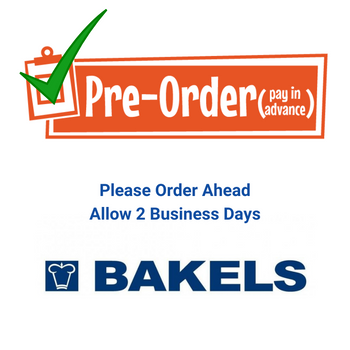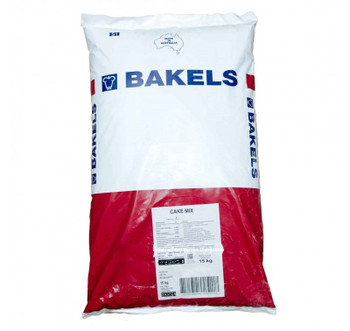Bakels
Bakels Cake Donut Mix 15kg
- SKU:
- DONCM15B
- MPN:
- 376001
- Availability:
- Non Stock Item | Please order 3 business days in advance
Description
Bakels 15kg Donut Cake Mix is a completely prepared mix for making cake style donuts.
- This is a non stock item so please allow a few days for us to order it in for you.
- Made in Australia
- Halal Approved
Ingredient Listing:
Wheat flour, Sugar, Vegetable oil (antioxidant (307)), Soy flour, Raising agents (450, 500), Milk solids, Egg yolk powder, Maize starch, Salt, Emulsifiers (322 soy, 471), Spice, Natural flavour, Vegetable gum (415).
Allergens: Contains: gluten, egg, milk and soy May be present due to shared equipment: sulphites
CAKE DONUTS MANUFACTURING GUIDE
What is the correct batter temperature?
The batter should be between 22 – 25°C. It can be regulated by adjusting the water temperature to achieve this range.
A way of estimating the temperature of the water to be used is as follows. If we assume that we want to reach a batter temperature of 23°C then measure both the dry mix and the air temperatures and add them together. Add 3 to this to allow for the heat generated during the mixing process and then take this total away from 69 (3 times the desired batter temperature).
This will give you a guide to the water temperature that you will need to use.
What happens if the batter is too warm?
The batter will have a short bench life due to the increased soda activity. The donuts will lack volume and may be out of shape.
What happens if the batter is too cold?
The donuts will stay under the fat for too long; they will fry too slowly and either tend to crack open or ball up. Also, they will absorb too much fat and lose volume.
Why is a resting time recommended?
A 10 minute resting period between mixing and cutting allows the dry ingredients to take up the water and is important to produce donuts with good volume and the correct level of fat absorption.
What happens if the resting time is too long?
If the resting time is longer than 10 minutes then the batter will start to “gas off” and the donuts will lose volume and shape and will absorb more fat.
What happens if the resting time is too short?
The donuts will have less volume than they should have and may be slightly tough to eat
What is the correct fat temperature for frying?
Best results are obtained when the frying fat temperature is between 188 – 193°C.
What happens if the fat temperature is too high?
The donuts will fry too fast on the outside. This prevents proper expansion and the donut volume will be less. Also, the interior crumb may be dense and the centre of the donuts may be raw.
What happens if the fat temperature is too low?
The donuts will spread, forming large rings and will tend to crack open. The crust colour will be pale and the fat absorption will be high.
What happens when the fat is too far below the cutter?
During cutting the donuts may drop flat and may turn over when
submerging or surfacing. The resulting donuts may be misshapen with rough or cracked surfaces.
How far should the frying screen be below the surface of the fat?
The frying screen should be between 5 – 7cm below the surface of the frying fat. This distance should be adjusted by adding or removing screens from the fryer so that the donuts rise to the surface with their top side, as dropped from the cutter, uppermost.
What happens when the screen is too near the surface?
The batter may stick to the screen and the donuts may not rise to the surface fast enough resulting in crusted or cracked donuts with low volume and markings from the screen.
What happens when the screen is too far below the surface?
If the screen is too far below he surface of the frying fat then the donuts may turn over while they are rising resulting in misshapen and cracked donuts.
How can donuts be prevented from sticking to the drainer screens in open kettle frying?
This can be achieved by keeping the drainer screens clean so that the donuts will break away quickly, rapidly rising to the surface of the fryer. Dirty screens should be cleaned using a wire brush and a mild solution of hot caustic soda (washing soda) to remove all material which the donuts may stick to.
NOTE : hot caustic soda is corrosive and care should be taken even when using a mild solution of it. The appropriate protective gear should be worn as per the manufacturer’s instructions.
After cleaning with it make sure to rinse all equipment thoroughly – heating caustic and fat together results in the production of soapy compounds!!
Can fat absorption be too low?
Yes, it can and donuts with insufficient fat absorption will tend to have poor keeping and eating qualities. Depending on the drop weight of the donuts, they probably should absorb somewhere between 3.5 – 7grams of fat per donut.
How can excessive fat absorption be prevented?
- By not adding extra water to the batter
- Mixing the batter for a little longer
- Giving the batter its correct floor time
- Having the batter at its correct temperature
- Having the frying fat at the correct temperature
- Replacing the frying fat so that it always reasonably fresh
- Turning the donuts promptly when they have taken on a golden brown colour
- By not over-frying the first side of the donuts
- By turning the donuts only once
NOTE : Remember that, unlike 99% of the products in the average Bakery, a donut is fried, not baked. Donuts usually take about 90 seconds to fry up and in that time a good product has to be made. That is the reason why it is so important to follow the correct procedure.
Any long term frying issues with donuts could be caused by incorrect temperatures due to a faulty thermometer. Thermometers should be checked and calibrated regularly by your equipment supplier or a certified person.
Never use liquid oils in your fryer. The oils do not solidify on cooling and fondants and cinnamon sugar will dissolve because of this.
CAKE DONUT TROUBLESHOOTING GUIDE
Key factors for making good donuts involve close attention to procedures and equipment set-up.
Following the instructions on the bag and in the above sections will normally prevent any problems while checking the following will also help.
- Batter temperature.
- Fat absorption.
- Mixing times and speeds.
- Temperature of the frying fat.
- Mix resting time.
- Time in the fryer.
- Condition of equipment (especially the cutter).
- Condition of the frying fat.
PROBLEMS & POSSIBLE CAUSES
Too much fat absorption:
- Batter too hot or too cold
- Fryer oil temperature too low
- Batter is too slack or too stiff
- Over expansion before turning
- Not enough mixing time
- Frying fat breaking down
Tough eating donuts:
- Batter has been overmixed
- Batter is too slack
Spreading:
- Batter is too slack
- Fryer fat temperature is too low
Donuts “Balling” up:
- Batter is too stiff
- Batter is too cold
- Batter has been overmixed
- Donuts have been turned in the fryer too soon
- Cutter setting is too large
Poorly formed donuts:
- Batter is too slack (or too stiff)
- Frying fat is too deep
- Faults in cutter/sleeve/plunger (nicks and worn spots will cause donuts too be poorly formed)
- Donuts are sticking to the screen:
- Cutter setting is incorrect
Donuts are cracking:
- Batter is too stiff
- Batter is under mixed
- Batter is too cold
Donuts have a rough crust:
- Batter is too stiff
- Batter is under mixed
- Batter is too cold
Donuts have poor volume:
- Batter is too hot (or too cold)
- Batter is too stiff (or too slack)
- Batter has been undermixed (or vermixed)
- Donuts have been turned too soon











